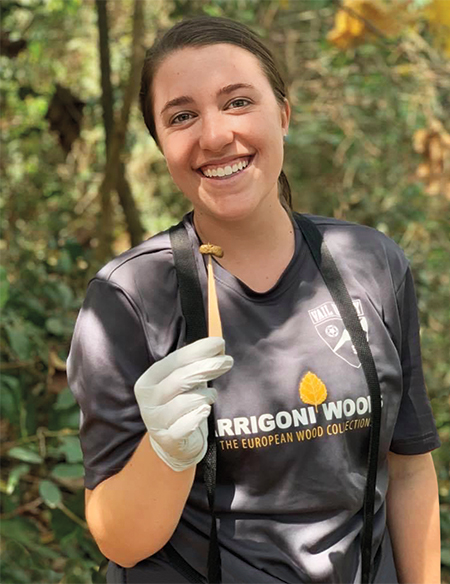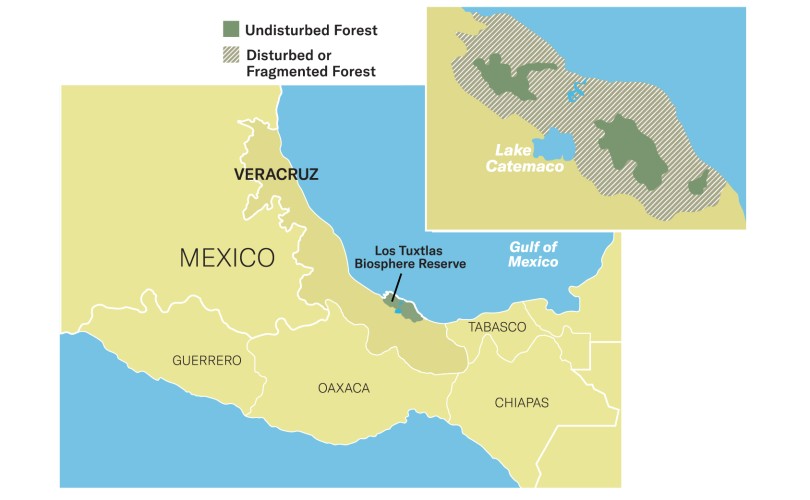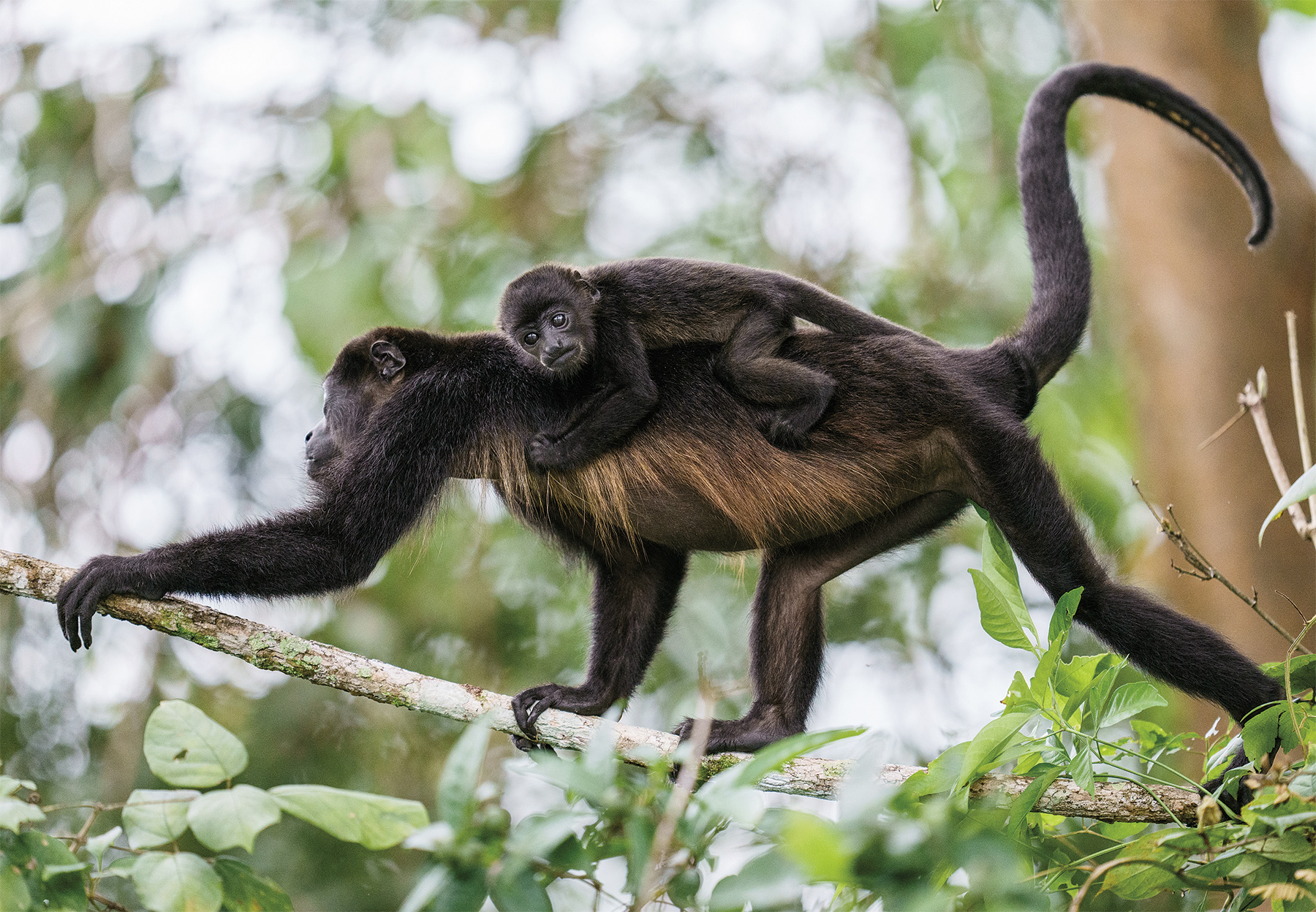Health Equality Is Next LGBTQ Priority
Now, perhaps more than ever, it is critical that we continue the LGBTQ movement’s fight for recognition and representation. The health of our community depends on it.
Researchers are collecting feces from endangered monkeys to create health metrics for conservation. By Carolyn Wilke
Pink, yellow and blue hues paint the early-morning sky over the Gulf of Mexico. Just a few miles inland from the coast in Veracruz, Mexico, three researchers take in the sunrise as they trek through a pasture and along a river, hauling stuffed backpacks. It’s damp, humid and verdant. They pass grazing cattle and hear the calls of distant birds — toucans, parakeets and chachalacas — and listen for the earsplitting cries of mantled howler monkeys.
The team is studying the health of these endangered primates and will trek until they see them. Some days it takes hours romping through the rainforest’s underbrush to find the animals. But today, after an hour of hiking over level grassland, the team reaches a patch of trees where they spot five or so mantled howlers, shiny and black, hanging out in the branches. Then the researchers hunker down for a bit, eat some breakfast and wait for the monkeys to do their business.
The mantled howlers continue their own morning routine. Eating is their primary waking activity. They munch on leaves, flowers or fruit and then settle down to nap. When they rouse a couple hours later, it’s go time for the scientists.
“The second they wake up is when they’re going to poop,” says Tabor Whitney ’22 MA, a fourth-year doctoral candidate who is studying biological anthropology at Northwestern. Whitney has been studying these monkeys since 2021, with Northwestern primatologist Katherine Amato.

Tabor Whitney, pictured here holding a fecal sample, spends two to four months each year doing fieldwork in Mexico. Once she finishes her doctorate, likely in 2025, Whitney hopes to pursue a career in science communication and conservation policy. She’s wanted to work in animal welfare ever since she learned as a child that logging in Colorado, her home state, altered habitats and displaced animals. As an undergraduate at the University of Oregon, she studied the microbiome of colobus monkeys in Ghana and understood that her research could affect conservation efforts. Credit: Diana Christie
The feces may contain clues about the monkeys’ physical condition and could aid Whitney in developing a “health index welfare assessment,” a tool that provides metrics that conservationists can use to make decisions about the endangered creatures. The mantled howler monkeys in this region, which includes the Los Tuxtlas Biosphere Reserve in southeastern Mexico, have lost about 75% of their habitat since the 1960s, as people have converted forests to crop fields, pastures and quarries.
In the time that she’s been working in Los Tuxtlas (she has visited for several months each year since 2021), Whitney has witnessed changes to the monkeys’ habitat firsthand. She recalls walking through a patch of rainforest cover near an expanding rock quarry and seeing a new break in the forest: The quarry operation had downed trees, splitting
a forest that had been connected the year prior. She knew human activity was swiftly changing the forest, but to see it with her own eyes was surreal.
“[The monkeys are] experiencing a major shift in habitat,” Whitney says. They’re living in smaller fragments of forest and with reduced access to the foods they prefer, including the fruits of ficus, cecropia and jobo trees. Climate change is exacerbating the problem by causing shifts in the seasonal availability of various foods. And human activity — including the noise from people and their dogs and machinery — also encroaches on the monkeys’ turf. As their habitats have fragmented and degraded, the primates’ numbers have declined — by an estimated 50% since 1993 — but their populations haven’t been snuffed out just yet.

Agricultural activities have led to deforestation in the Los Tuxtlas Biosphere Reserve, which includes some of the last remaining pockets of tropical rainforest along the Gulf of Mexico. According to researchers, 14% of the current forest cover in the region will be gone by 2025. Map credit: Michael Newhouse
They’ve survived in part because mantled howler monkeys can adapt their diets to what’s available. They prefer fruit (and play an important role in the ecosystem by spreading seeds) but can get by on leaves, including mature ones that are difficult to digest. However, humans’ influence on the howlers’ habitat could be triggering health problems that are hard to spot and may ultimately affect the subspecies’ ability to survive. Studying the molecules and microbes contained within fecal matter may provide a noninvasive way to snoop on the stress levels, presence of inflammation and overall health of the primates.
Whitney plans to use the data she collects from the mantled howlers’ feces “to form conservation and management strategies for them.”
Back in the forest, as the monkeys in the trees above begin to stir, the researchers train their eyes on the primates’ posteriors. When a monkey looks like it’s got a deposit to drop, Whitney or one of her research assistants gets ready to track the trajectory. If the scientists are lucky, the plop of poo lands on a rock or leaf, leaving it uncontaminated by soil, which contains lots of other microbes. To retrieve the sample, the researchers scour the thick vegetation until they find the prize. Then they drop it into a vial of ethanol and log the emitter’s identity. (Researchers can identify particular monkeys based on patches of lighter fur and markings on their paws.) The samples are shipped back to a lab on the Evanston campus, where Whitney and her colleagues will investigate their microbiomes.
Whitney works with Amato, her adviser and an associate professor in Northwestern’s Department of Anthropology in the Weinberg College of Arts and Sciences. Amato’s interest in primates and fieldwork stemmed from a second-grade lesson on primatologist Jane Goodall. “I never thought I would actually do [what Goodall did],” Amato says. “It seemed like such a far-off reality.” But during her undergraduate studies in biology at Dartmouth College, Amato studied abroad in Costa Rica, doing a 10-week field ecology boot camp where one of her projects compared the behavior of howler, spider, capuchin and squirrel monkeys. After college, she spent a year studying two species of howler monkeys in Mexico, observing their feeding behavior and examining their feces to compare the variety and amounts of seeds they spread.
In 2008, when Amato was beginning her doctoral program, research into the microbiome, including that of the gut, was gaining traction. Working with mice that were reared without any microbes, researchers had recently discovered that a transplant of gut microbes from a person who was overweight caused the mice to develop obesity. Likewise, microbes from people who were lean led to leaner mice. Amato started to think about how microbes could contribute to the biology and health of their hosts in the wild, too.
Scientists also were discovering key roles that gut microbes play in processing food and providing energy to their hosts. Amato wondered whether the gut’s microbial community could help wild primates get enough energy when food was scarce or when nutritional needs were high, such as during pregnancy. Amato investigated this question, studying black howler monkeys in Palenque National Park in southern Mexico and tracking how their microbiome shifted with seasonal changes in diet.
Like the mantled howler monkeys, black howlers will eat leaves when fruit is unavailable. “That’s a pretty big change,” Amato says. While fruit is loaded with sugar and easy to digest, leaves contain a lot of fiber — making them harder to digest — and may also contain toxins. Still, even when the monkeys had to swap fruit for leaves, they were able to maintain the same level of activity. Amato’s data suggested that the monkeys’ microbiome helped them get enough energy from leaves.
Amato wondered whether the monkeys’ microbiomes would help them weather changes in available foods when their habitats were degraded. To explore this question, Amato collected fecal samples from monkeys in different forest fragments. “And the answer was no: The howler monkeys had microbiomes that were very different in fragmented forests, and different in ways that suggested that microbes were producing less energy,” she says. Monkeys living in smaller, fragmented forests also seemed to have more pathogenic microbes, suggesting a link between impoverished habitats and health risks. “These fragmented forest environments look like they may be causing the microbiome to be less resilient and less able to help hosts buffer themselves nutritionally.”

Whitney is building on her adviser’s findings with her work on the mantled howler monkeys of Los Tuxtlas. On her most recent visit in fall 2022, Whitney and her team collected samples from about 100 individual monkeys from 10 different forest fragments to study health metrics. So far, the team has documented a dip in the diversity of the monkeys’ gut microbiomes as their habitats’ quality has declined. But it’s not yet clear if and how those changes are linked to poor health.
In addition to surveying the makeup of the monkeys’ gut microbiomes, Whitney is analyzing the fecal matter for other markers of health. One such marker, lipocalin-2, is associated with intestinal inflammation and found in people who have irritable bowel syndrome. So far, researchers have seen a link between this molecule and inflammation in lab animals, but Amato and Whitney would be the first to find this link in a wild animal population.
Whitney is also measuring glucocorticoids, a set of steroid hormones. If monkeys have relatively high levels of these molecules across fecal samples at different times, they are likely experiencing chronic stress. Whitney’s co-adviser, Pedro Américo Duarte Dias, a primatologist at Universidad Veracruzana in Xalapa, Mexico, and his colleagues reported an uptick in monkeys’ glucocorticoids, which they linked to high levels of human activity near the animals’ habitat. The bump in glucocorticoids didn’t correspond with other potential explanations, such as aggression against other groups, but seemed to be a result of nearby human activity and its noise.
If Whitney, Amato and their colleagues can draw out the connections between the mantled howlers’ gut microbiomes and health markers such as inflammation and stress hormones, it may provide a new, noninvasive way to track the monkeys’ health that’s simpler and faster than the current methods. Information on the monkeys’ conservation status is typically gathered via decades-long population surveys. These counts can take 30 to 60 years to show generational differences — a long time to wait in a rapidly changing forest. But fecal samples, which are easy to collect from wild primates, could provide metrics that can be monitored every couple of years.
“This work has great potential to advance our ability to use the microbiome as a conservation tool,” Amato says, noting that this monitoring methodology could be applied to other species as well. “So many of the world’s primate species — upward of 60% — currently are threatened or endangered.” Trying to manage so many threatened species is like trying to extinguish many fires at once, so the new welfare assessment tool may help conservation groups prioritize the primates facing the greatest risk.
Whitney is already working on this. She is developing a database for the primatology community to share adaptations to her methods for gauging fecal indicators of health. Because primate species have different diets, the makeup of their feces will vary, with different concentrations of microbes or hormones to measure. A database of methods would foster communication about methodological choices among scientists, Whitney says.
In Los Tuxtlas, Whitney also has completed land surveys and tree counts to measure the size of the forest and map the monkeys’ food availability. Ultimately, she and Amato want to understand the combined effect of deforestation and habitat loss, diminished food sources and human interaction on the health of these monkeys.
Whitney hopes to identify targets in the fecal samples that could be easily monitored to help policymakers conserve the mantled howlers. For instance, if conservationists are able to link a specific stressor — such as noise from dogs or lack of a particular food — to changes in one of the health metrics, they could track the metric in fecal samples for years to come. That might reveal whether potential solutions — such as installing fences to keep dogs out or planting fruit-producing trees — would lessen monkeys’ chronic stress or inflammation levels. Meanwhile, researchers could look to the monkeys’ gut microbiomes to detect whether shifts in bacterial species and their abundances might help the animals digest certain foods.
Whitney is looking forward to sharing the results of her work with communities in Veracruz, including the lakeside city of Catemaco, where she stays during her fieldwork, and other nearby towns. She plans to return to Catemaco in January to connect with nongovernmental organizations, landowners and community members to discuss what she’s found — but also to hear their observations about the monkeys’ behaviors and diet.
Whitney is also eager to get back into the forest. While her fieldwork is fun, it isn’t exactly a walk in the park — long days of tracking the howler monkeys can be grueling and sometimes fruitless. Snakes, bugs and mud are regular features of her treks. And “getting pooped on is 100% going to happen by the end of the project,” she says. “But it’s so worth it.”
Carolyn Wilke ’18 PhD is a Chicago-based freelance science writer and editor. Wilke studied environmental engineering at Northwestern, investigating the potential effects of nanoparticles on bacteria. She was in the first section of the University’s Skills and Careers in Science Writing course and, while earning her doctorate, reported on research as an American Association for the Advancement of Science Mass Media Fellow at The Sacramento Bee. Her work appears in The New York Times, National Geographic and Scientific American.
Reader Responses
No one has commented on this page yet.
Submit a Response